AppleInsider · Kasper's Automated Slave
About
- Username
- AppleInsider
- Joined
- Visits
- 51
- Last Active
- Roles
- administrator
- Points
- 9,814
- Badges
- 1
- Posts
- 63,192
Reactions
-
What's really going on with Apple's modem chip efforts?
A recent report suggests Apple's in over its head with it's iPhone modem efforts, but -- to borrow a phrase -- we think differently.
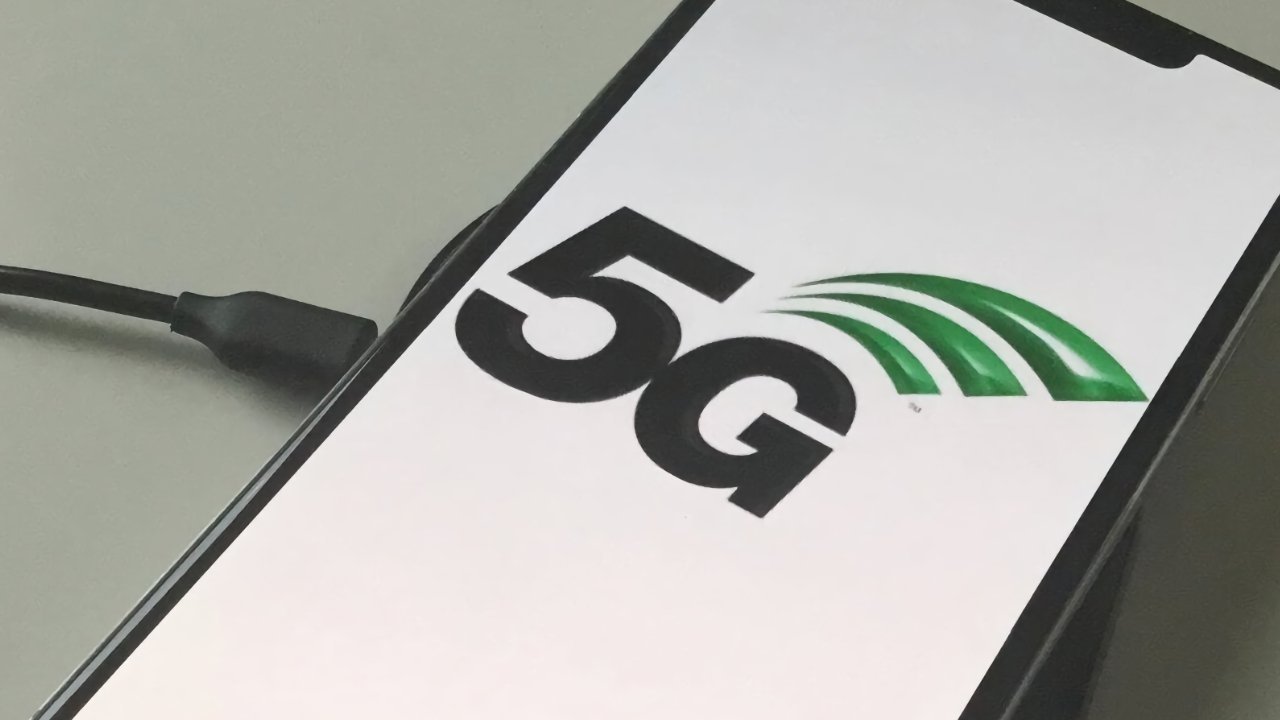
Apple is trying to make its own 5G modem for the iPhone
Apple knows what it's doing and knew what it was getting into from the start. But even the folks queried by the Wall Street Journal admit right off the bat that getting cell modems working right is no small feat.
That is among the many reasons why Apple uses Qualcomm components in its iPhones, has for years, and will continue to do so at least through 2026, as Qualcomm itself recently acknowledged.
It's no surprise that Apple has stayed mum on the subject. We expect that once it has something to talk about, it will, just as it does about A-series, M-series and other chips it makes -- look at the time it spent at the recent iPhone and Apple Watch launch crowing about the chips inside.
Apple's seemingly inevitable switch to its own modem hardware has been an open question since 2019, after Apple acquired Intel's cell modem business in a $1 billion deal that netted Apple 2,200 employees, facilities, technology, and a bevy of patents to help kickstart its modem efforts.
But this has been a long time coming. Much, much longer than that.Apple's custom silicon history
Apple's experience with custom integrated circuit design long predates the iPhone, and even the Mac, for that matter.
Apple co-founder Steve Wozniak designed a one-chip floppy disk controller solution for the Apple II called the IWM (Integrated Woz Machine). Apple's been designing its own custom silicon solutions ever since, such as the AIM alliance with IBM and Motorola which yielded the PowerPC processors used in Macs for years.
Apple was also fundamental in launching Arm, the company that owns the IP behind the processors Apple now designs for its own products. Arm -- founded in 1990 as Advanced RISC Machines Ltd. -- was a joint venture between British PC maker Acorn Computers, Apple and VLSI Technology.
Before it became the semiconductor juggernaut it is now, Arm made processors used in Apple's Newton MessagePad and other products.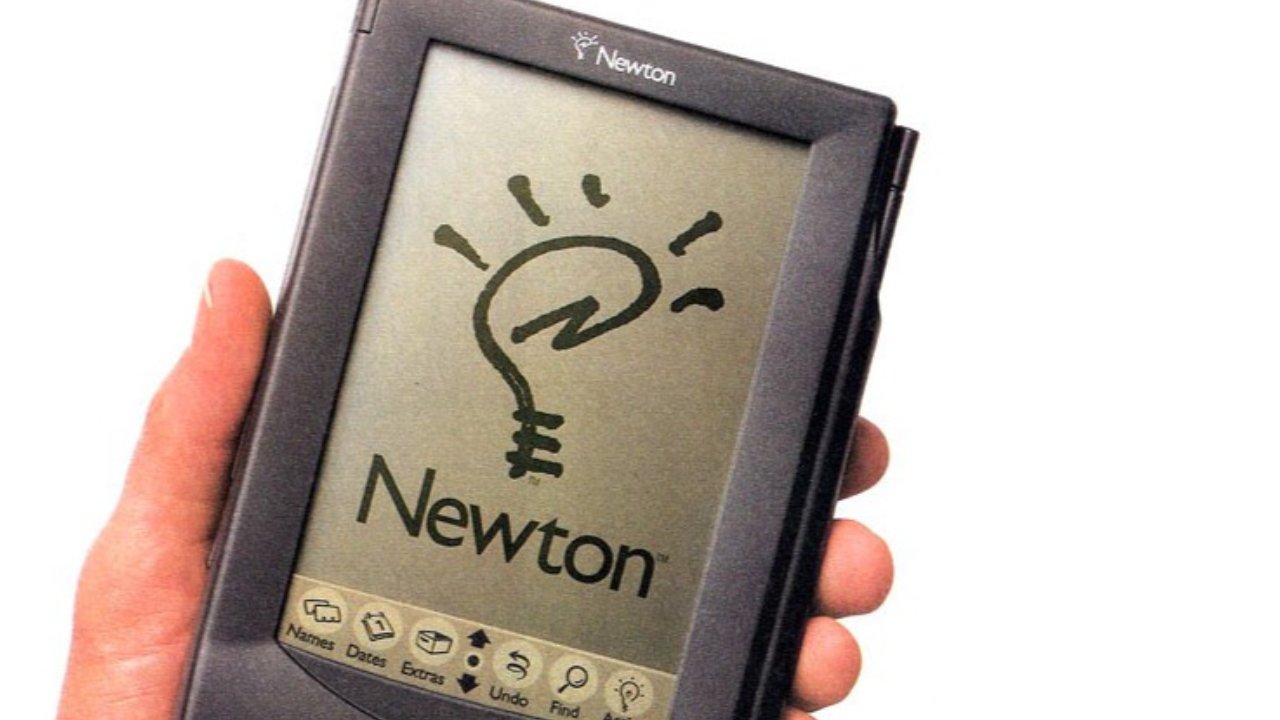
Apple's Newton MessagePad ran on an ARM-designed processor
More recently, Apple was among Arm's key strategic investors for its 2023 IPO, agreeing to a new chip technology deal that "extends beyond 2040," according to an Arm regulatory filing.
Apple bought chip design firm P.A.Semi in 2008, kicking its own chip design efforts into gear and yielding results beginning in 2010 with the introduction of the A4, the SoC inside the iPad, the iPhone 4, 4th-gen iPod Touch, and the 2nd-gen Apple TV.
By the time Apple acquired Intel's cell modem business in 2019, the company had already been developing its own mobile-focused SoC designs for more than a decade, led by the company's Senior VP of Hardware Technologies, Johny Srouji.
Contrary to the implication in the WSJ article, Apple knows what it's doing here, even though the stakes in 5G might be a bit different.
The article claims that by late 2022, Apple's modem hardware was about three years behind Qualcomm. Tantra Analyst founder and principal Prakash Sangam points out that Samsung and Huawei have run into challenges to develop hardware that can compete with Qualcomm.
"[Samsung and Huawei] are definitely not beating but not even equal to Qualcomm in terms of performance, feature set support, number of bands, and band combinations" said Sangam.
Given the amount of time Apple has purportedly been developing its modem hardware, Sangam thinks Apple is actually on track, not behind. From Sangam's perspective, Apple may have thought it could make a modem quicker than other companies but reality has caught up to it.
"That's more in line with Samsung and Huawei's timelines, so that seems realistic," he said.
"Building [a] modem is hard, which Apple is realizing, unlike its SoC effort. So, that is worth noting," Sangam added.Why Qualcomm?
Qualcomm isn't the only company that makes modem silicon for cell phones, but they're the 800 pound gorilla, because they've been center-stage in the business since there was a business.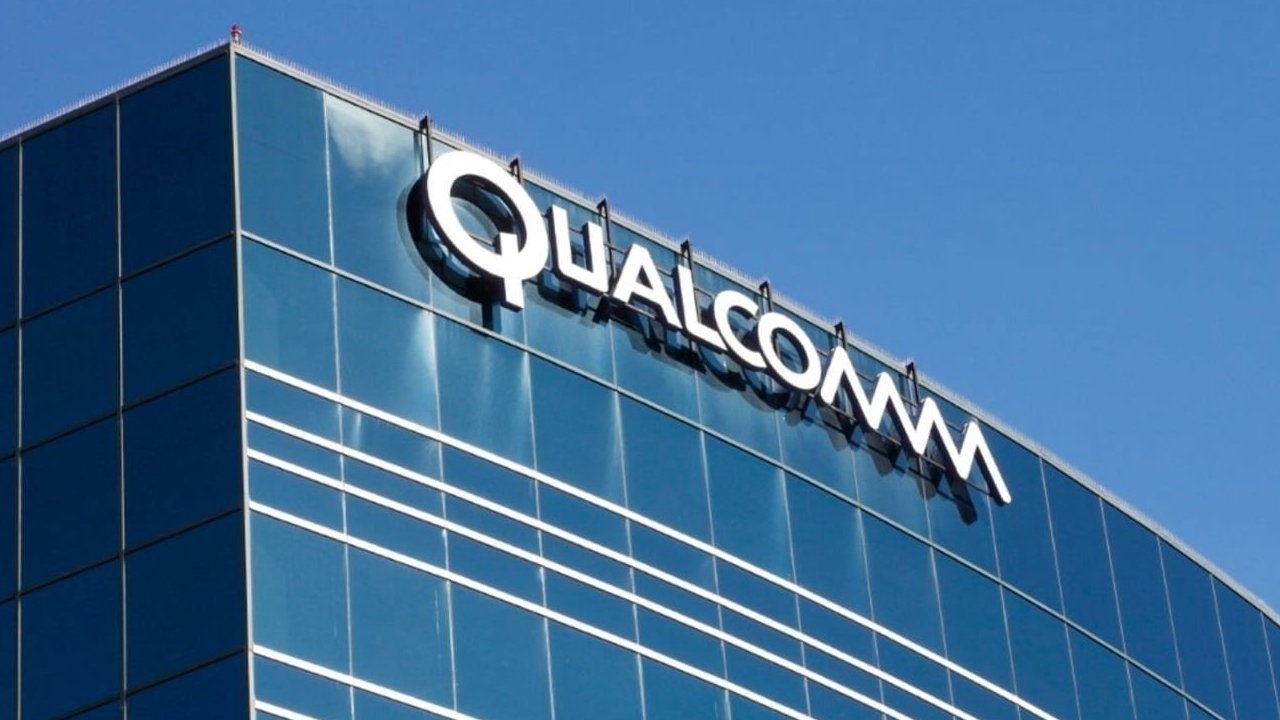
There are few smartphone manufacturers with the volume and the acumen to pay Qualcomm for licenses while still rolling their own chips, like Samsung and Huawei. It only makes sense then that Apple should be in that mix, so why isn't it?
Bottom line: if you're a smartphone maker, you're either paying Qualcomm for parts, licensing Qualcomm IP, or paying someone else to license Qualcomm's patents.
Apple found itself doing more than one of those things at a time. Which is one reason why Apple and Qualcomm have dragged each other through U.S. federal courts on and off, for years.
Qualcomm is an IP juggernaut, with more than 140,000 patents under its belt, many of which are essential to the operation of cell phones -- what's known in IP law as "standards-essential patents" or SEPs. The company's licensing business nets it billions in annual revenue.
The baseband processor is the radio network interface for a cell phone -- an essential component for it to operate. Apple didn't start out using Qualcomm-made baseband chips, but Apple's complicated history with Qualcomm goes back to those first iPhones.
For the first several years of the iPhone's development, Apple used baseband chips made by German semiconductor maker Infineon. Apple eventually negotiated a licensing deal with Qualcomm, leading to an exclusive deal between the two companies in 2011. That deal didn't work out, so the companies sued each other, eventually settling out of court in 2019.
Legal actions between the two companies have erupted ever since, though Apple's efforts to overturn Qualcomm's patents in court have been pretty consistently rebuffed by federal judges straight up to the Supreme Court, which refused to hear their case in 2022.
At this point the two companies are in an uneasy state of detente. Qualcomm chips are still in iPhones, and Qualcomm says that it will still be providing chips to Apple through 2026.
The question isn't if this will change, but when. Apple's continued reliance on Qualcomm for such a key component of the iPhone is, without question, not what the company wants to do.
Tim Cook has been telling investors since 2009 -- about a year after the P.A. Semi deal was announced -- that Apple wants to own and control the primary technologies behind its products.
One interesting footnote here: Infineon, the company that provided Apple with the baseband modem for the first iPhones, sold its wireless business segment to Intel in 2011 after Apple made its deal with Qualcomm. It's much of that business Apple would spend $1 billion for, less than a decade later.5G: a moving target
Even if Apple has more than enough expertise to design an effective baseband chip, it's still wading into very deep waters with its own cell modem. The telecom industry operates in very long cycles of technology development and deployment, and 5G is still very much a work in progress.
5G is all we hear about, both from Apple and from network operators trying to upsell us to the latest plans. And in fairness, 5G now blankets most population centers around the U.S. and China.
But we're still very much living in a 4G world, 14 years after the technology first debuted.
For some perspective on this, consider a few data points offered by telco giant Ericsson. The company's latest annual network coverage outlook noted that global 4G coverage extended by late 2022 to about 85% of the global population.
By comparison, global mid-band 5G coverage had only reached about 10% of the global population (30% inside of China). Those coverage figures actually put 5G ahead of where 4G was at the same stage of its deployment. But there is still a lot of runway, and "5G" itself is very much a work in progress.
The process of rolling out new generations of cell tech starts with the 3GPP, an organization that develops and maintains global telecom specifications. Those specs are then implemented by regional standards bodies, then later filter down to semiconductor companies and handset makers.A seat at the table
Implementing a new generation of phone technology is a bureaucratic effort that takes years, filtering through to hardware makers once the details have been worked out in endless committees. Apple, unlike Qualcomm with its thick stack of essential patents and other players, was starting from scratch with the 3GPP after the Intel acquisition.
Apple lacks representation on the chairs of 3GPP committees, and, in fact, the 3GPP implemented new rules this year precisely to prevent individual businesses from gaining too much power and influence within the groups which vote on 5G feature and service design and deployment.
The rule doesn't single out Apple. But the company's recent efforts to stack groups with members mirrors what other telecom businesses have been also been trying to do, necessitating the change.
Meanwhile, the 3GPP and the telecom industry is moving towards the release of "5G Advanced" features. Those are aimed at improving network performance to gear it up to support virtual reality, AR and MR.
There can be little question that as Apple sees this as crucial to its spatial computing efforts. The Vision Pro is only the first spatial computing device Apple has planned, and it's entirely dependent on wireless local networking.
But it's easy to imagine portable implementations of the technology which take advantage of future high-speed, low-latency cell connections to provide users with a realistic and immersive experience even when they can't get on Wi-Fi.
Those new capabilities are still in committee for another year or two, and it'll be even longer still before they're etched onto silicon. This makes it a good time for Apple to get in the mix with its own hardware.
"One thing going for them right now, at least for next one or two years, is the incremental jump in feature sets and capabilities on 5G modems," said Sangam. "It's a kind of an improvement that has slowed down."There's nothing to see here, move along
We understand well that there's no love lost between Apple and Qualcomm, after years of legal wrangling and broken and renegotiated contracts. But that doesn't mean Apple is fumbling its own solution just to get them out of the way, in fact, quite the contrary.
It's clearly in Apple's best interest to control its own destiny with its silicon rather than leaving such a crucial piece of the iPhone puzzle to an unreliable partner. That keeps in line with Tim Cook's doctrine of controlling principle technology.
And it's important to note that Apple has dramatically expanded chip engineering efforts in recent years, opening new development centers in Israel to accommodate the rush of new projects.
Ultimately, the WSJ paints a very unflattering portrait of Apple's modem efforts that simply doesn't pass the smell test for anyone with even a passing familiarity with how Apple runs, or how the telecom business operates.
The truth is more mundane: It simply takes time and many iterations to get this sort of technology right, especially for a company like Apple that only wants to project technological primacy for its flagship products.
Read on AppleInsider
-
New iPhone 15 teardown gets into microscopic detail
A brand-new teardown of the iPhone 15 uses a microscope to highlight what's tucked away beneath the shell of Apple's flagship smartphone.
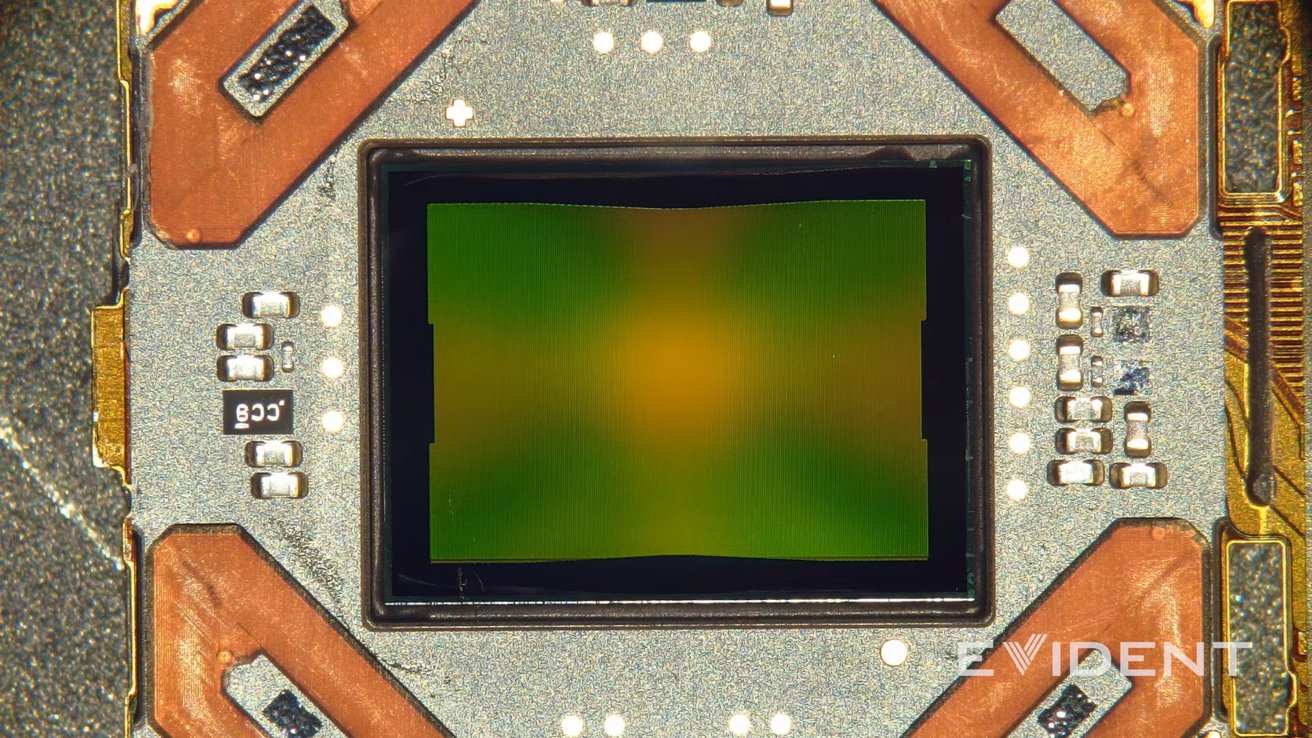
Image Credit: iFixit
Every year, iFixit does teardowns of Apple's yearly iPhone releases. This year is a little different, thanks to a partnership with Evident Scientific. The teardown now includes footage from a DSX1000 microscope, allowing viewers to get an up close and personal look at the inside of the iPhone 15.
As iFixit notes, the inside of the iPhone 15 doesn't look too dissimilar from the inside of an iPhone 14.
The video notes that the microphone on the base iPhone 15 and iPhone 15 Plus allegedly is now reparable in-store. However, that does not seem to be the case for the iPhone 15 Pro lineup.
When removing the battery, they discover it features a new message that reads "Warning: Trained Technician Serviceable only."
When it comes time to disassemble the camera module, they show off the 48-megapixel image sensor. They note that even though the iPhone 15 and iPhone 15 Pro both have a 48-megapixel camera, the quad-pixel buckets in the base iPhone 15 model are 22% smaller. This results in worse performance in low-light settings.
The logic board seems to be easier to repair this year. Often, the logic board must be accessed by removing the screen, but on the iPhone 15, the brackets that hold the board are also accessible from the back.
They wrap up the video by giving the iPhone 15 a preliminary 4 out of 10 reparability score. This is largely due to Apple's tendency to pair parts with software components, limiting which parts can be used to make repairs.
Read on AppleInsider
-
What's new in iOS 17.1 beta 2: StandBy mode options, ringtones, & more
The second beta of iOS 17.1 was released this week and we installed it on our new iPhone 15 Pro Max to see what new features or changes it holds. Let's dig in.
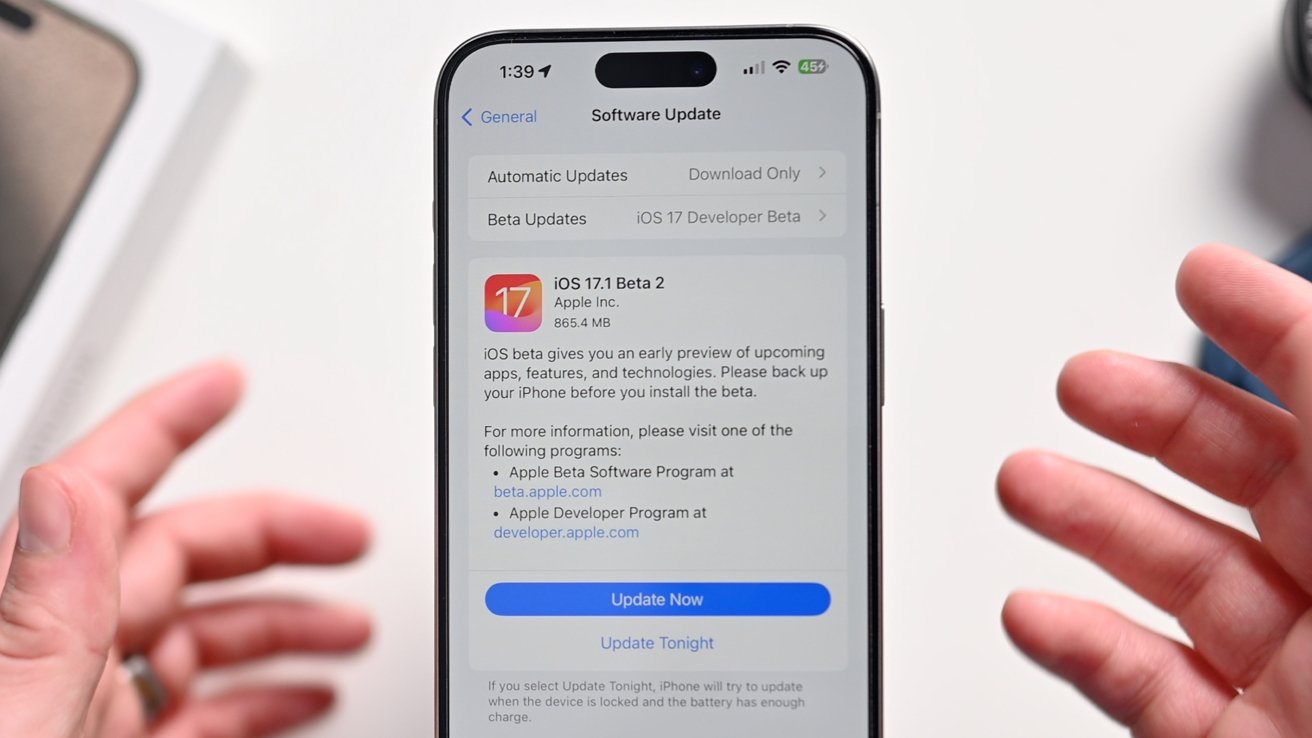
New beta of iOS 17.1
This latest developer beta weighed in at just under 900MB for our iPhone, though your model mileage may vary based on your device. The version number is 21B5056e where the "e" at the end will get closer to "a" as we approach release.
We thought that Apple could be ready to include the as-of-yet-unreleased Journal app with iOS 17.1, but as of this second beta that doesn't appear to be the case. It could still happen by release, but it would be unusual to not have it available for testing earlier in the cycle.Changes in iOS 17.1 beta 2
After plenty of user feedback, Apple is providing display options for StandBy mode. Many users disliked that the display would turn off after a period of time.
The new setting gives users of the iPhone 14 Pro, iPhone 14 Pro Max, iPhone 15 Pro, and iPhone 15 Pro Max three options for StandBy mode.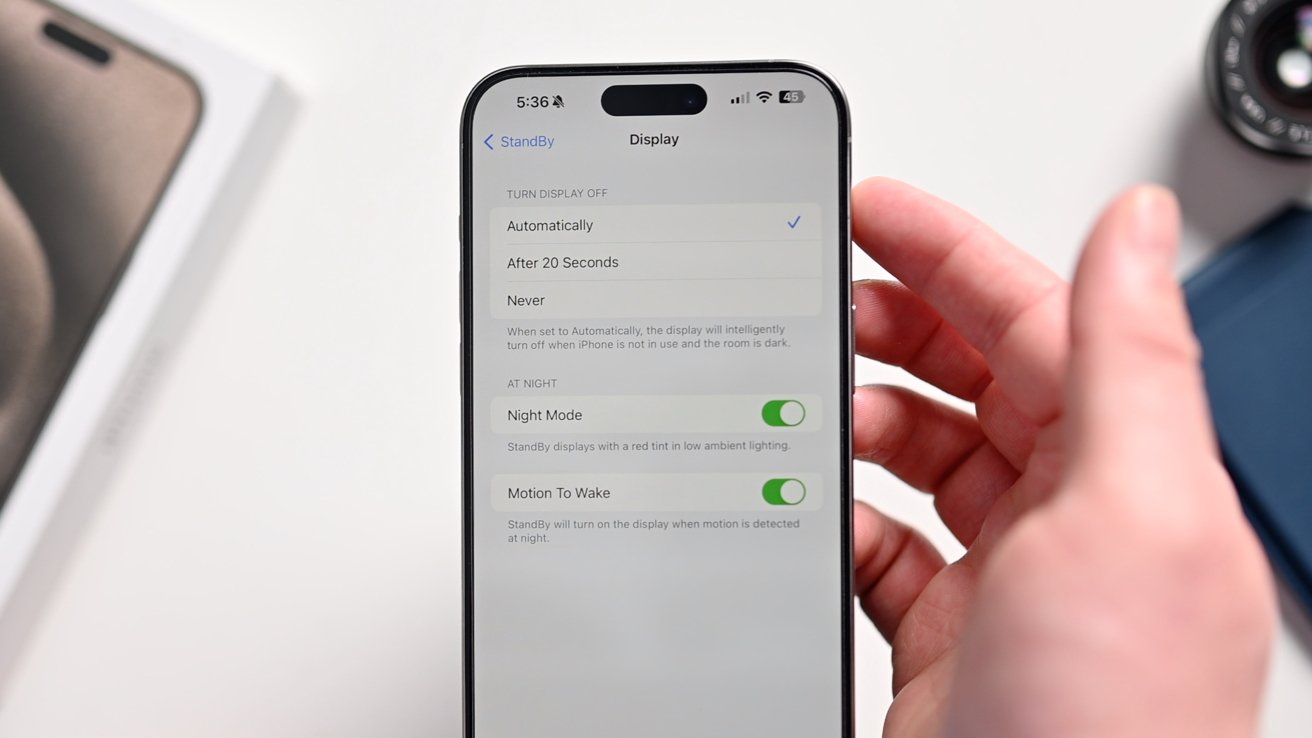
New display options for StandBy mode
The display can turn off and on automatically, after 20 seconds, or never. The ability to stay on requires the always-on display found on the last-two generations of pro iPhones, which is why it only supports those outlined above.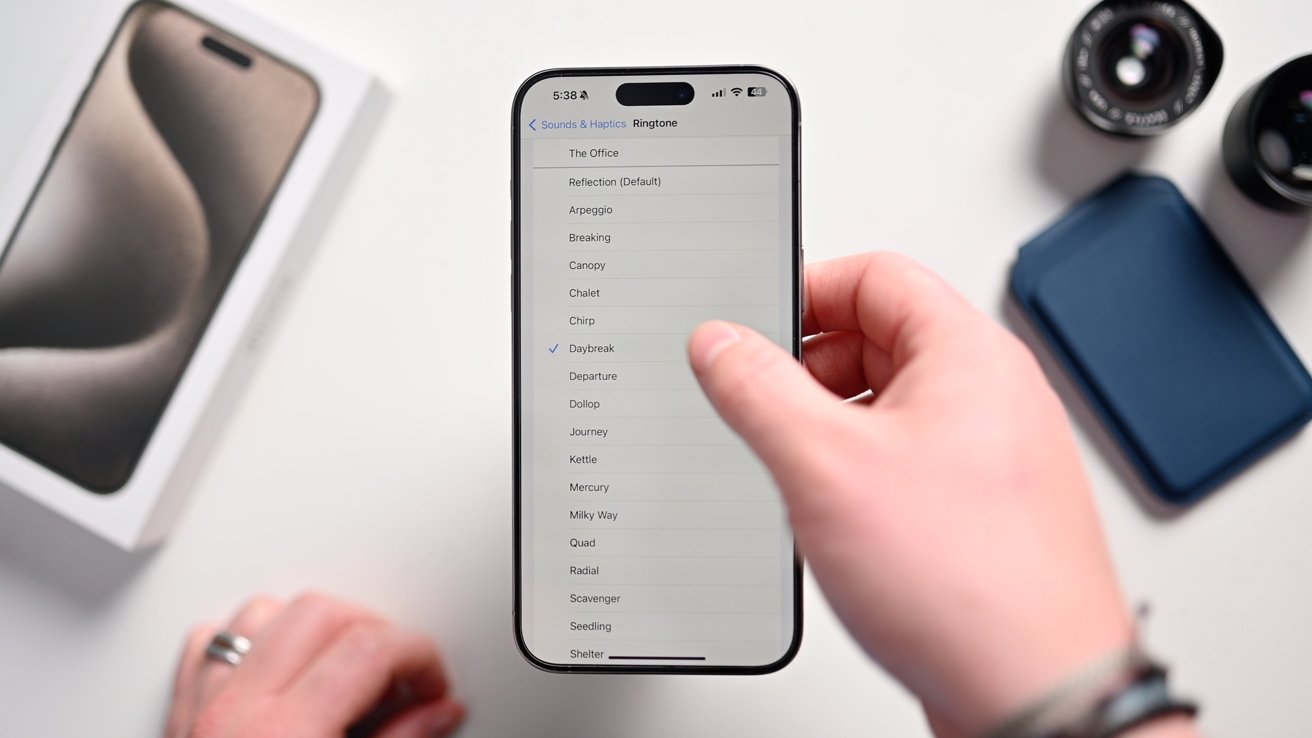
Ringtones and text tones arrive once more in iOS 17.1 beta 2
Beta 2 also returns the ringtones and text tones that were included with iOS 17 but absent in the first beta of iOS 17.1. The first iOS 17.1 beta was seemingly compiled before iOS 17 was released so they didn't make it into that first developer release.
This also fixed a bug that prevented custom tones from being set and from widgets appearing blank in macOS Sonoma.Coming soon
Apple will likely release a public beta of iOS 17.1 beta 2 on Wednesday. The next developer beta will probably arrive on October 10th.
What isn't clear, is whether Apple will opt to quickly release an iOS 17.0.3 build to address the overheating issue plaguing the iPhone 15 series or if it will bundle it with iOS 17.1 later this month.
Time will tell which route Apple takes. Spot any other changes? Let me know on X @Andrew_OSU.
Read on AppleInsider
-
Thronmax Space wireless mic kit review: an almost-great option for vloggers & more
The Thronmax Space wireless mic kit includes a useful and well-designed pack of condenser and lavalier mics and accessories that drops the ball with no included support for Apple mobile devices.
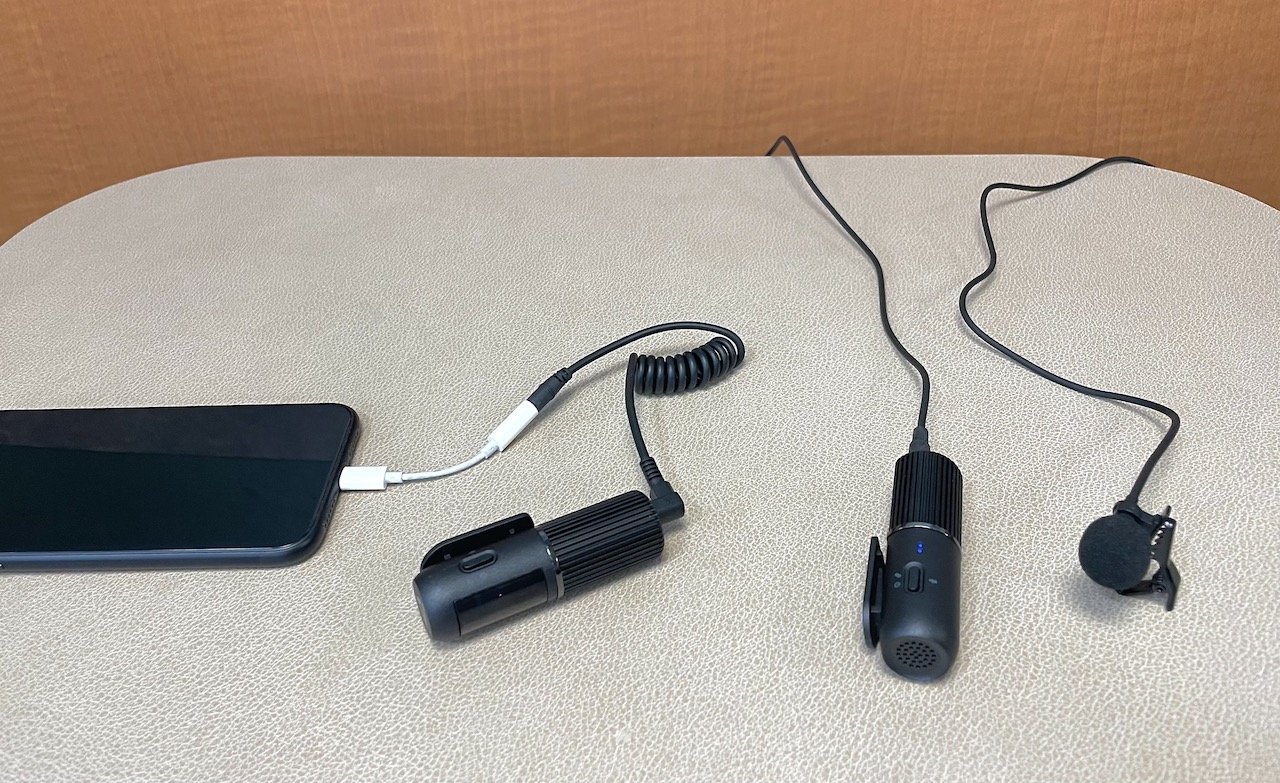
Thronmax has been making USB microphones for quite a while, but mostly the sort you might use for video-conferencing or podcasting when you need an upgrade from built-in mics. Their forthcoming Space mic set adds to their desktop line by expanding into wearable wireless mics.
This package is a great option for photographers, filmmakers, interview shows, or anywhere you need a wireless microphone. The kit comes in a "presentation" metal box with some faux leather on the top.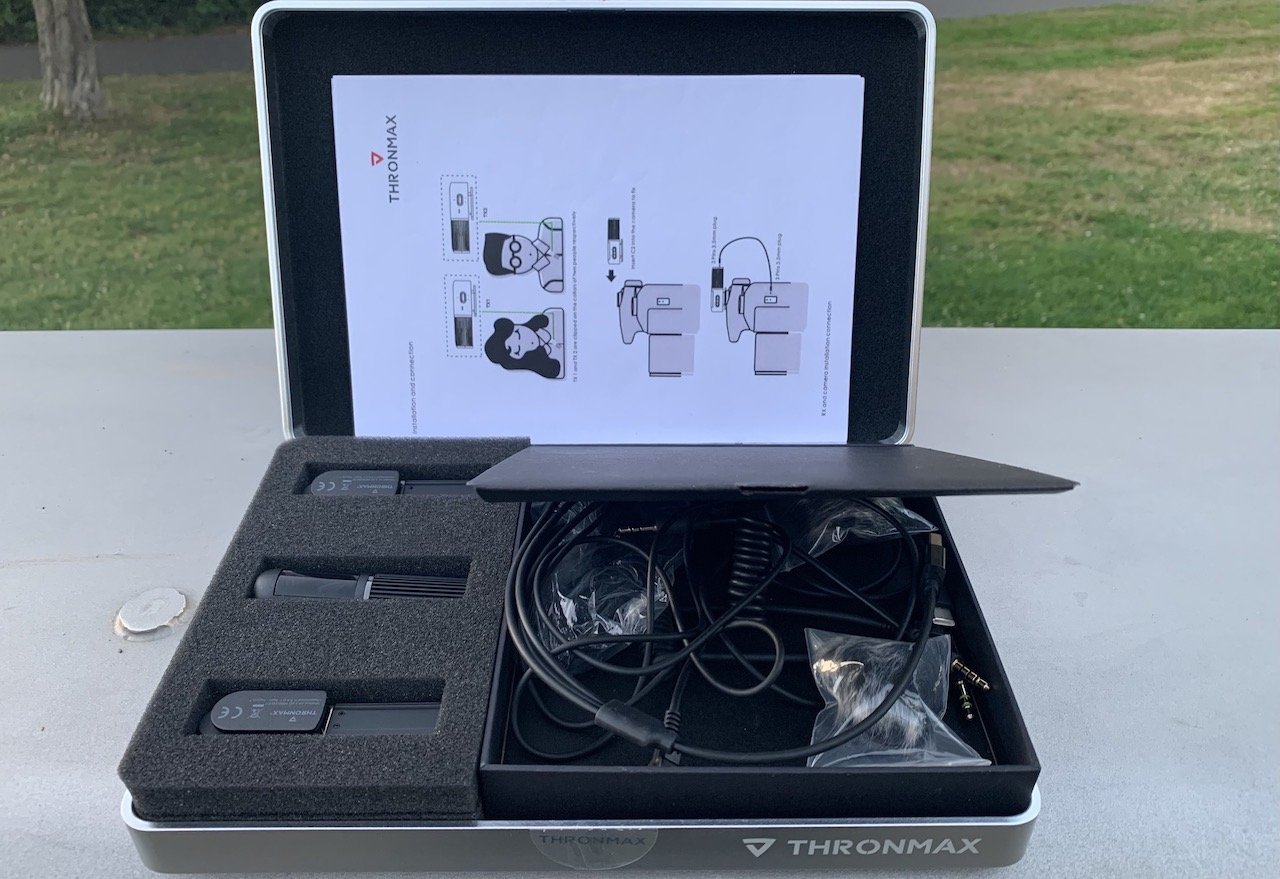
The presentation box
This nice touch makes it useful as a tray for easy access to the other items or as a soft top to rest delicate equipment, like a DSLR. The kit includes:- Two condenser microphones that double as wireless transmitters
- Two lavalier mics with TRS cords that attach to the transmitters
- A receiver module designed to look a lot like the transmitters
- A vastly smaller zippered carrying case that everything can squeeze into for portability
- Two windscreen filters for outdoor work
- A TRS-to-TRRS adapter cord (compatible with Apple headphone jacks)
- A TRRS-to-USB-C cord (Android-only, according to Thronmax)
- A USB-A to USB-C tri-head cable (for charging the mics and receiver)
- A two-page "manual" that explains what each piece is and some of its controls
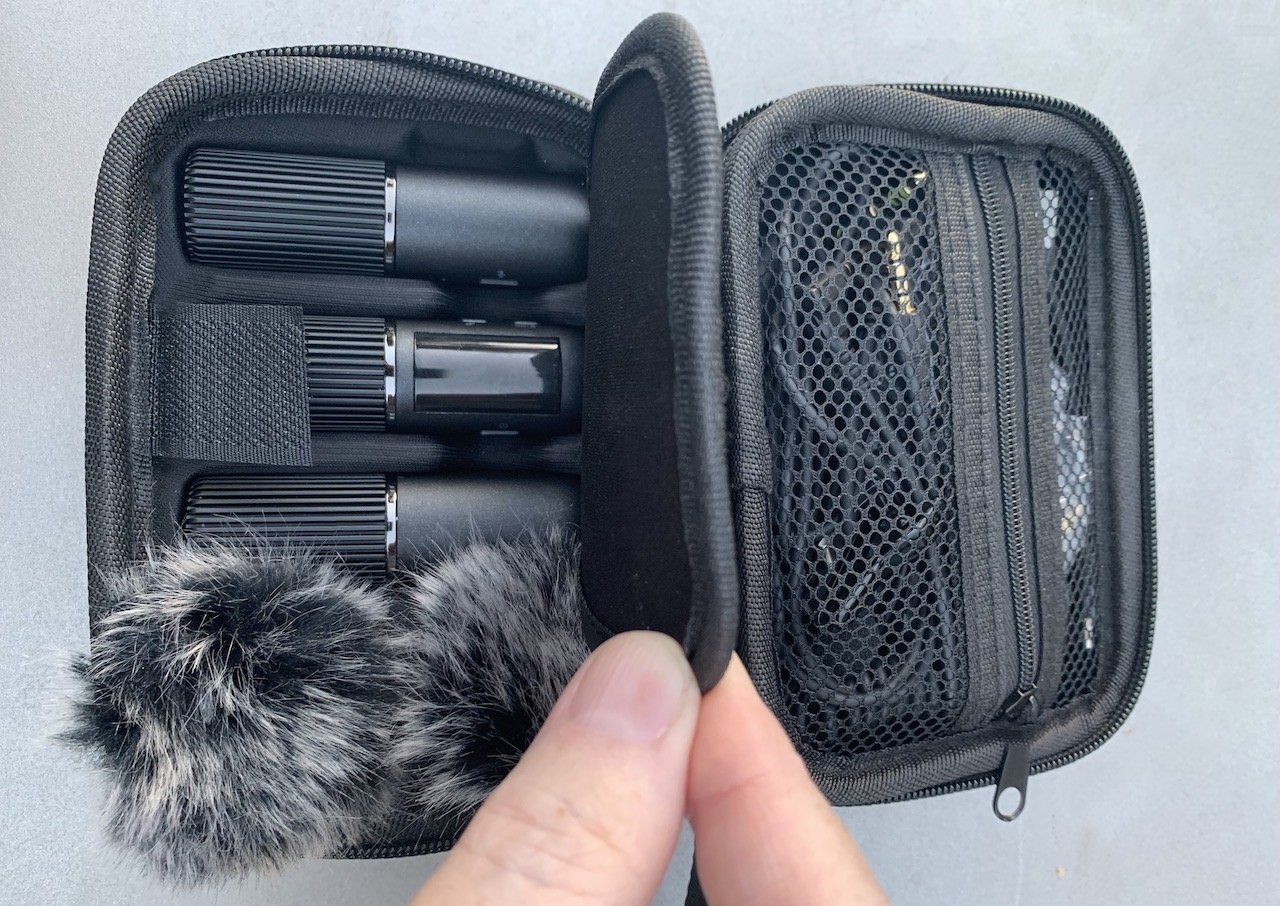
The more compact travel version with the same contents
It's what this kit forgets to include that makes it frustrating for Apple users. To record these mics flowing into an iPhone or iPad, you must buy a TRRS adapter to Lightning and a TRRS adapter to USB-C.
If your Mac includes a headphone jack, you can use the included TRS-to-TRRS cord without issue. But the point of this kit is to record almost anywhere, so having no included way to record directly to an iPhone or iPad is a major shortcoming.
Thankfully, Apple sells TRRS adapters as 3.5mm headphone adapters for Lightning or USB-C for a mere $9 each. They work as mic and headphone adapters because they work with the built-in mic on EarPods.
To briefly explain TRS and TRRS for those unfamiliar: if you look at the plug end of a 3.5mm headphone or microphone, you'll see a metal sleeve topped by a shaped tip and some black markings along the sleeve. The bit of the metal sleeve between the markings is called a "ring."
A 3.5mm wired headphone that does not have a mic built-in will have one ring and is known as TRS, or Tip-Ring-Sleeve. The "ring" area is usually used for right-channel sound, and the tip is used for the left channel.
When a wired headphone does include a mic, you'll see three black markings, designating two "rings." This is a TRRS or Tip-Ring-Ring-Sleeve mic, where the tip is used for the left channel, the first ring is used for the right channel, and the lower ring is for grounding.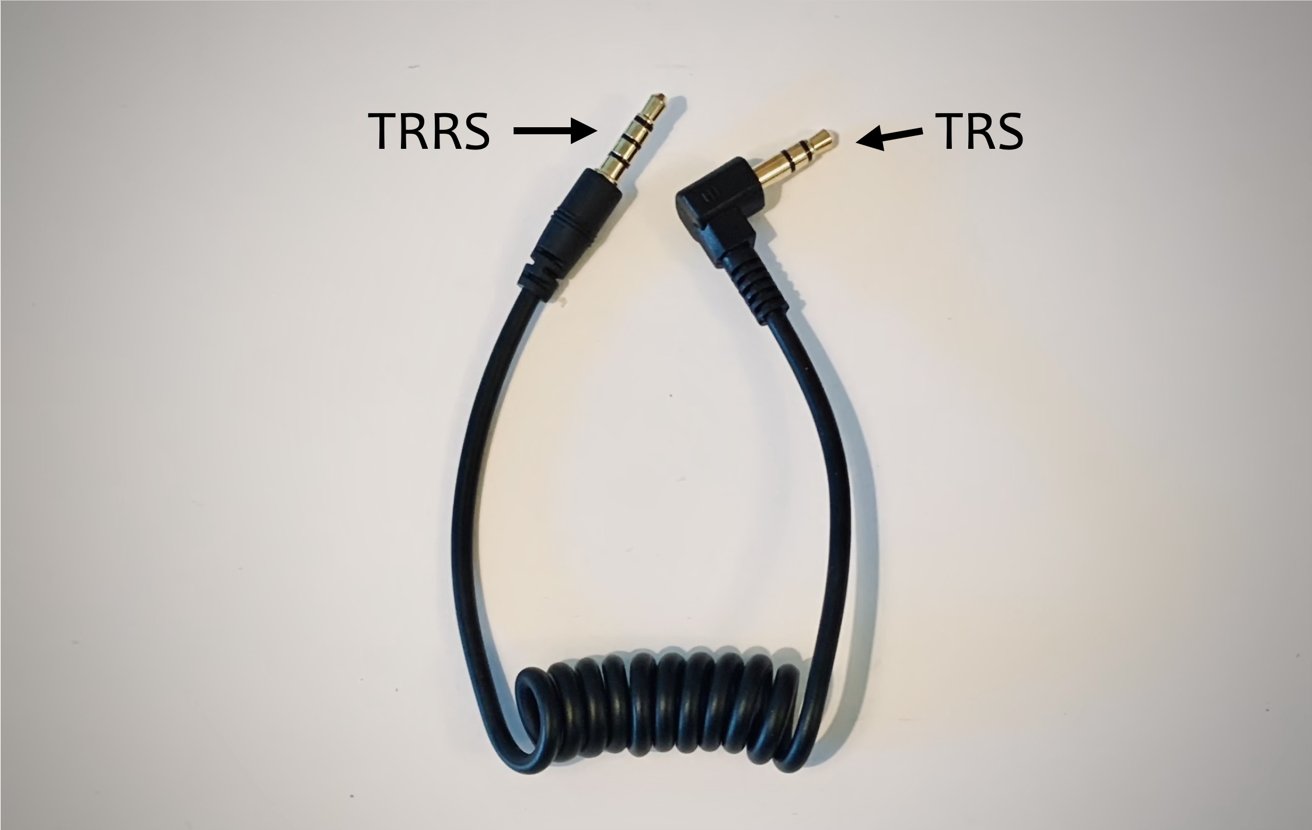
The TRRS plug goes into your adapter or headphone jack for Apple devices.
The wireless transmitters in the Thronmax Space kit are a brilliant bit of design work. Instead of just being transmitters, they double as small-capsule condenser microphones.
They feature a nice, compact, and rounded "barrel" design that will blend right in if you're wearing black or dark grey. You can use the included lavaliers if they're too bulky for your needs.
The lavalier mics plug into the transmitter and turn off the condenser mic. Being smaller mics, the lavaliers lose some sound quality but, like the condensers, can be combined into a stereo pair if desired.
The mic/transmitters and the receiver module feature a clip that works well with the vest, shirt collar, or jacket thickness. The clip also slides right into a camera's hot shoe for easy recording if you're using a DSLR, as most YouTubers do.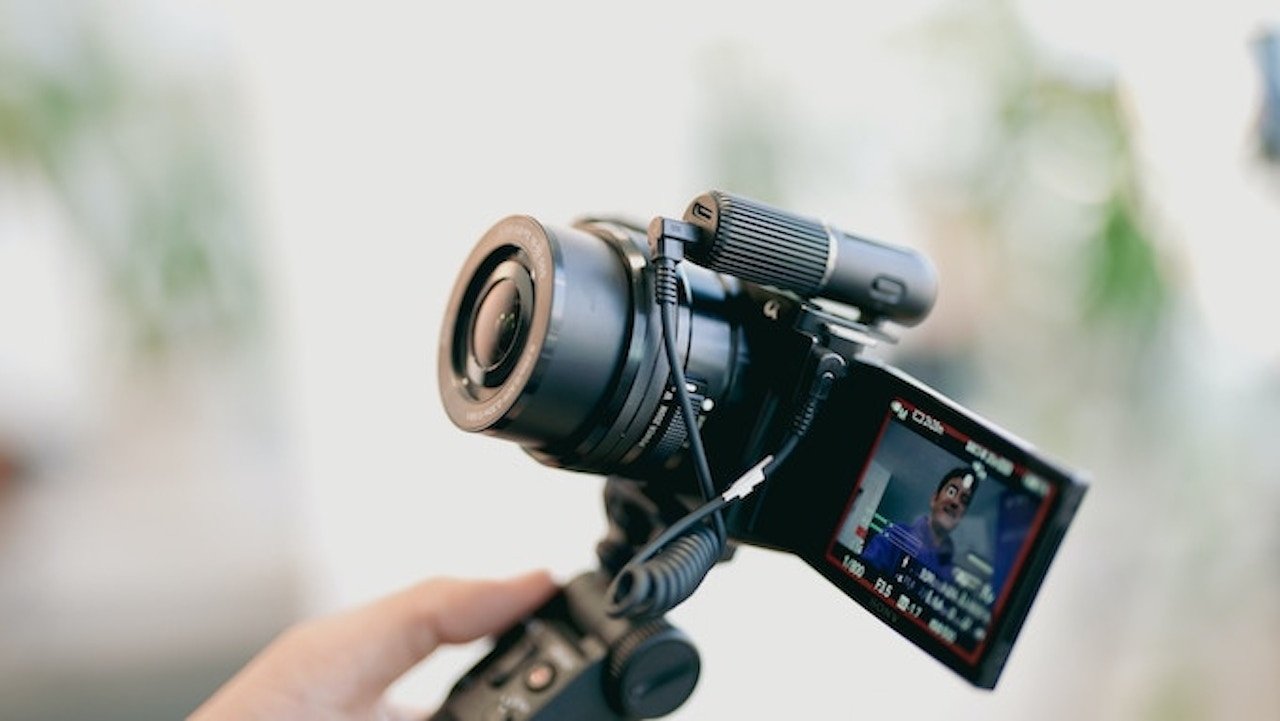
The clips on the mics and receivers fit perfectly into a DSLR's hot shoe.Thronmax Space kit - Microphones
The condenser mics shine when you have someone speaking, but you also want some of the ambient environment sound-- for example, the echo of a church or the sounds of the beach. The lavaliers are best suited to an interview situation or when you want much less ambiance to be included with the voice.
Microphones this compact are, of course, no match for large-capsule USB or XLR mics such as Blue's Yeti, Rode's NT1, or Thronmax's array of desktop mics. But they do a good job of capturing voice with highs, lows, and midrange tones.
Even more importantly, the audio has no detectable "lag" that could cause sync issues with any recorded video. Our testing found this held true even when the subject was a considerable distance away.
These microphones have an impressive range when it comes to line-of-sight distances. We put them to the test in a 60-foot long, reverberant underground car park and different outdoor locations, such as by the ocean, while equipped with the provided windscreen. According to the manufacturer, these mics can maintain signal even at greater distances.
Indeed, we never once lost signal -- even when our back was turned, walking away from the receiver, or as far as 200 feet away.Thronmax Space kit - Cords and hardware
One key factor to ensure a good-quality recording is learning the receiver module's minimalist controls. As with the transmitter mics, the on/off button is unmarked but pretty obvious, as it's set off away from other buttons.
We found that the transmitters and receivers paired instantly without fail -- no pairing required. That said, you can hold the power button on the transmitters to force pairing if necessary.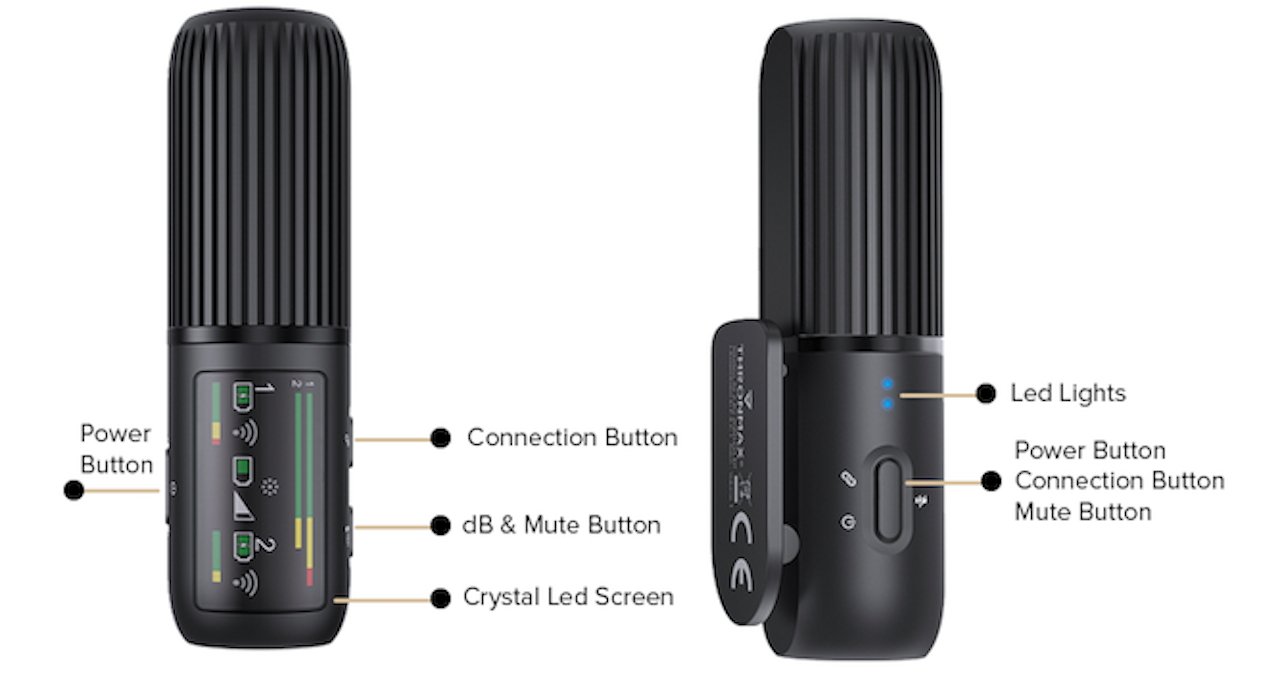
The receiver module also has a separate power button, an unmarked force-pairing button, and another unmarked button for adjusting the gain. Oddly, the gain is by default on full -- which will result in distorted audio if the mic is too close.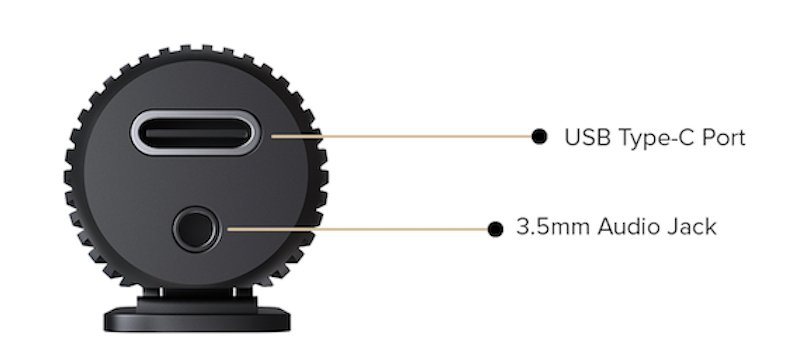
The underside of the condenser mics/transmitters. USB-C is for charging only.
In our testing, the two-thirds setting helped in noisy environments. The one-third setting was the norm for routine in-studio or quiet outdoor recording.
Once the gain is set, it is remembered until changed again. When the two mics are paired to make a stereo, they are perfect for recording nature sounds or live music.
The battery life on the mic/transmitters and receiver was also excellent, averaging about eight hours of "on" time. They can be quickly recharged using the tri-head USB-C cord to a USB-A port on a handy PC, older Mac, or battery pack.
If you don't have an available USB-A port because you're on location, you can use an adapter or hub to allow charging from a USB-C port. You shouldn't need to recharge on a typical location shoot, but it's best to have a battery pack to hand if you do.
The travel case makes for a tight fit to get everything in. However, it is wonderfully small and compartmented to make it easy to put everything in its place -- even the fuzzy, tiny windscreens.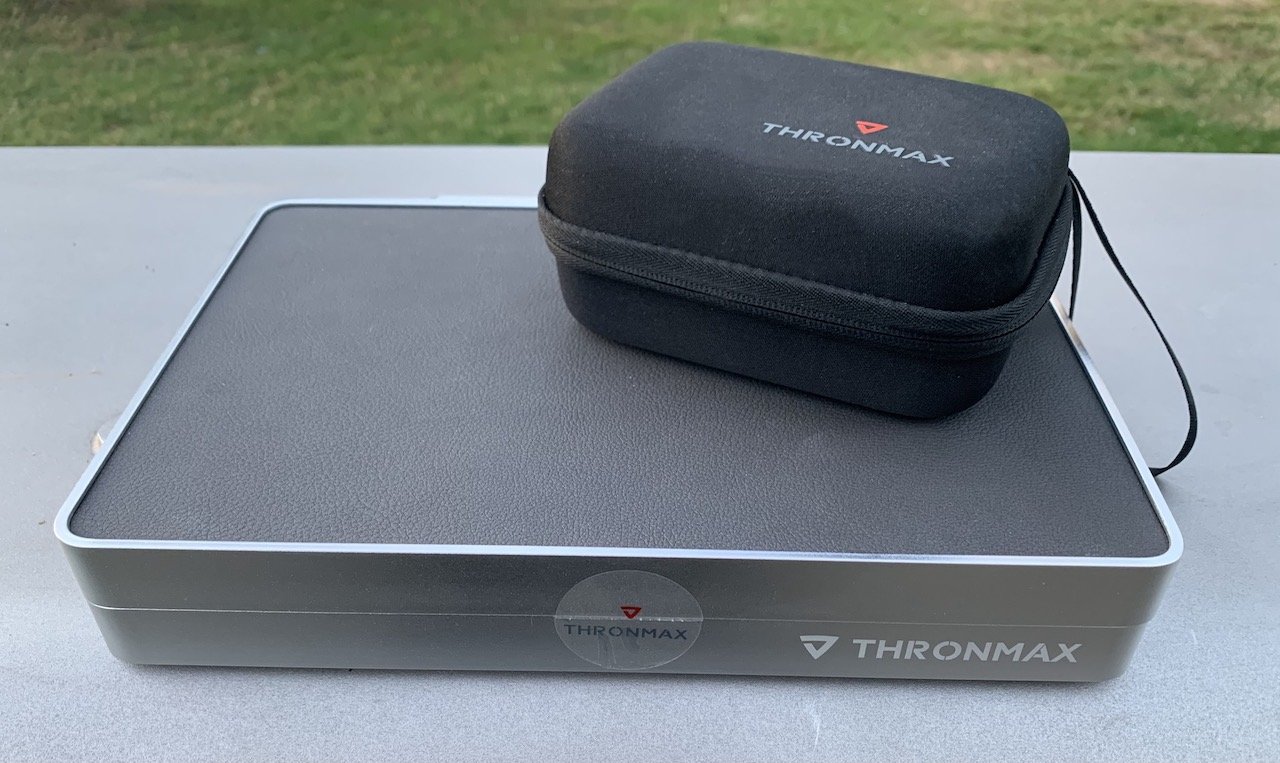
The presention box, and included (and far more practical) travel case.
The designers put a lot of thought into the presentation, and it shows. This is why we are somewhat confused that the company does not make any sort of recording software for mobile devices -- for any platform.
We used Rode's Connect app for mobile devices since it easily "sees" when an external mic is available. Macs can use Rogue Amoeba's excellent Audio Hijack.Thronmax Space mic kit - Falls short of expectations
It's important to note that the version of the Space wireless mic kit we reviewed is pre-release. Thronmax may correct the software, cords, and full Apple compatibility issues by the time it appears on retail sites and in stores.
Given their decent track record with Macs for their desktop USB mics, we hope the final product will be more Apple-friendly. You are good to go if you're using an Android phone with a USB-C port for your recorder, apart from an actual recording app.
We have to review the product as we received it -- and the lack of included iOS/iPadOS cord compatibility stops this from being a four-star review. Thronmax should also develop its own smartphone recording app or partner with another company to provide an app.
Simply put, using this kit should not require ordering one or more Apple accessories. An Apple-compatible Lightning and USB-C to TRRS adapter should be in the box, even if that means making the travel pouch a tiny bit bigger.
The condenser mics themselves, and especially the combo mic-and-transmitter design, are very high-quality and well-designed. They have a sound on par with some of their competitors in this small wireless-mic space, such as the Rode One wireless system or the Saramonic version.
The included lavaliers, being smaller mics, are, of course, not quite as good. That said, they are well-suited to keeping ambient noise low and fine for any scenario where hiring a boom mic operator would be impractical.Thronmax Space wireless mic kit - Pros
- Two mics and two types of mics included
- True stereo recording option
- Line-of-sight distance is impressive
- Rock-solid pairing and connection
- Good battery life, easy to recharge
- Unique, well-built design
Thronmax Space wireless mic kit - Cons
- No included iOS or iPadOS cables
- Extra Apple accessories needed for iPhone/iPad recording
- No accompanying recording app available
- Charging cord connects to USB-A
Rating: 3 out of 5
Where to buy the Thronmax Space wireless mic kit
This project was originally fully funded via Kickstarter and IndieGoGo. Afterwards, it became available to preorder from the Thronmax website, priced at $169.
Read on AppleInsider
-
Apple confirms iOS 17 fix for overheating iPhones is on the way
The iPhone 15 overheating issue is being worked on by Apple, the company has confirmed, with an iOS 17 bug and third-party apps blamed for some of the hot iPhone reports.
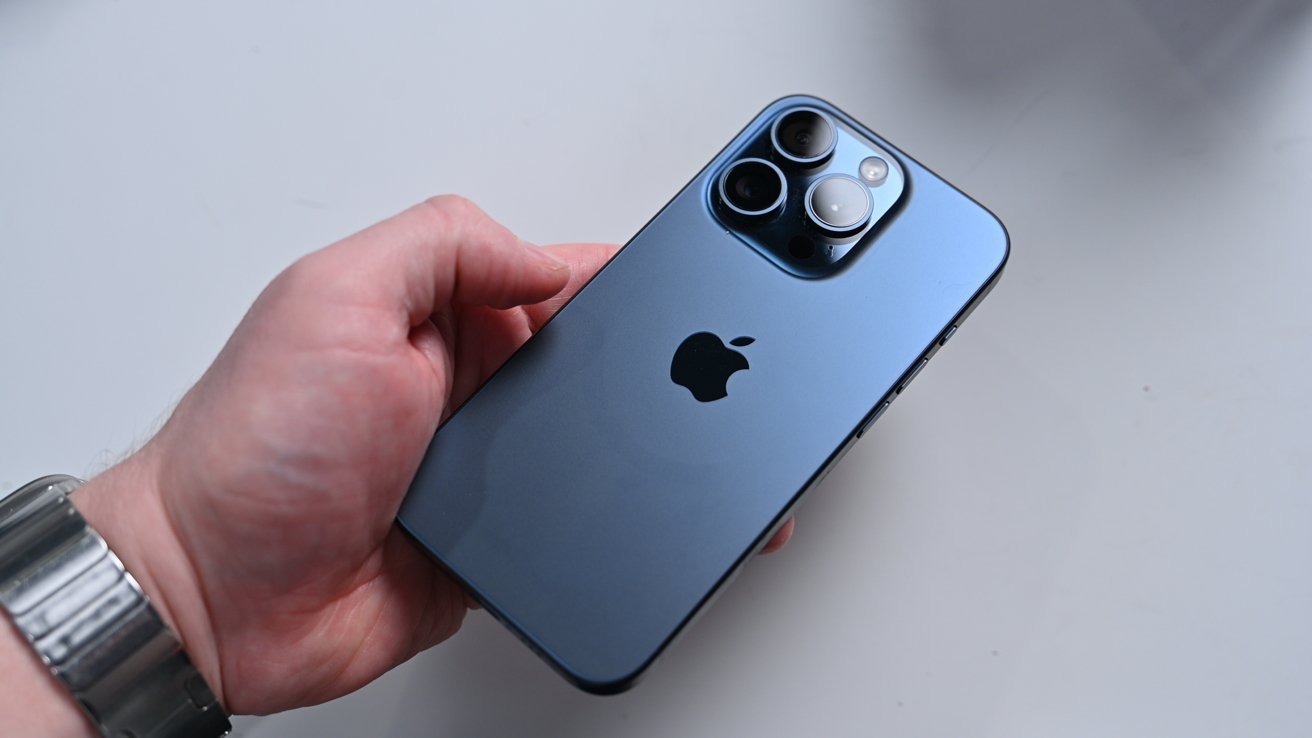
iPhone 15 Pro
Following the launch of the iPhone 15 and iPhone 15 Pro lines, Apple has had to face claims and reports about the new smartphones overheating in various situations. On Saturday, the iPhone maker has confirmed it is aware of the reports, and it's working to solve the problem.
In comments received by Forbes on the matter, Apple states "We have identified a few conditions which can cause iPhone to run warmer than expected." During the first few days of setting up or restoring a device, Apple advises some warmth can be expected "because of increased background activity."
This activity can include the iPhone redownloading apps and bought content, as well as a lengthy period of indexing all files for Spotlight search.
Apple brings up software as a second port of call for the heat issue. "We have also found a bug in iOS 17 that is impacting some users and will be addressed in a software update," Apple says without specifying what the bug actually is.
"Another issue involves some recent updates to third-party apps that are causing them to overload the system," Apple continued. "We're working with these app developers on fixes that are in the process of rolling out."
One prominent example of third-party app problems is Instagram, with it claimed to not only overheat the iPhone but to also heavily consume the battery for brief periods of time.
Testing via YouTube personalities determined that there were occasions when using Instagram triggered overheating for up to 10 minutes at a time.
While reports from the public focused on Apple's latest smartphone launches, it seems at least for Instagram that it affects other models too. Some iPhone 14 generation devices had the same heat issues as their iPhone 15 counterparts, again using Instagram and after updating to iOS 17.
Speaking to CNet, Apple also added to the list of affected apps, mentioning Uber and Asphalt 9 as overloading the A17 Pro's CPU. As for Instagram, an update was released on September 27 to combat the issue.
Apple also touched on charging, confirming that the iPhone 15 Pro and Pro Max support any USB-C adapter that is compliant with the USB-C standard, along with USB Power Delivery. Apple also said it caps charging to a maximum of 27W, and that a warming of the iPhone can occur when charging beyond 20W.
Apple didn't advise when it would issue a fix for the situation, but there's a chance it could be incorporated into iOS 17.1.
Read on AppleInsider



